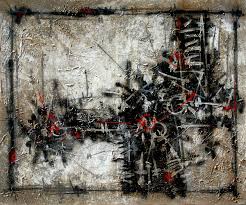History of Cuban painting, influences and aesthetic concepts that determined its evolution to the present day

The true origins of Cuban painting date back to the pre-conquest period, when the indigenous groups of Guanatahabeye, Siboney, and Taino coexisted or prevailed. Although these groups did not achieve the development of other settlements in Central and South America and were exterminated in less than a century, they left a lasting mark, particularly through the pictograms found in many caves and interestingly decorated pottery pieces, the latter in the case of the Taino, who were skilled in ceramics.
With the Spanish colonization and the subsequent immigration of peninsular artists, pieces by European artists were gradually introduced, which would become part of the visual world of later generations, the Creoles. Already in the first century after the Spanish conquest, there are references to a visual work whose artist was born in Cuba: the retablo or main altar of the Parroquial Habanera, by Juan Camargo, about whom no other information or pieces are known. In the 17th century, around 1646, another Cuban painter named Juan de Salas y Argüello had donated his work “San Miguel Arcángel y Nuestra Purísima Concepción” (Saint Michael the Archangel and Our Immaculate Conception) to the church of the Convent of Santa Clara, run by the Poor Clare nuns, in Havana.
By the 18th century, some Creole painters were already well-known, including José Nicolás de la Escalera y Domínguez (1734–1804), Juan del Río (1748–1846), and Vicente Escobar y de Flores (1762–1834), who were portraitists and also continued the tradition of religious imagery. At the same time, some also dedicated themselves to the “trade” occasionally, including people known for other reasons, such as the poet Juan Francisco Manzano and the conspirator José Antonio Aponte, both Black, in a slave-owning and, consequently, deeply racist society. On the other hand, popular pictorial images proliferated, by unknown authors, expressing the exuberance of the tropics and elements of Cuban identity before the island became a nation.
In the 19th century, Cuban painting was fundamentally defined by academicism. This was influenced by the nineteenth-century historical and social context, with the emerging rise of the Creole bourgeoisie, which looked to the old European world and its artistic refinement, with its romantic influence. The founding of the San Alejandro School (originally known as the Free School of Drawing and Painting) in 1818 determined the establishment of this model, where the indigenous social dimension was sometimes relegated. The natural landscape and rural areas were captured, but from a sentimental and idyllic perspective. Esteban Chartrand y Dubois (1840-1883) from Matanzas played a prominent role in this.
The dawn of the 20th century, particularly the 1920s, brought with it an innovative process in Cuban painting. At the same time that authentic national expression began to emerge, many artists had the opportunity to tour important cultural centers and draw on diverse artistic trends, breaking the isolation that had prevailed in previous centuries. The San Alejandro School continued to be the preeminent training center for Cuban painters, but it became more flexible in terms of conceptual and aesthetic principles; for example, in 1937, Eduardo Abela founded the Free Studio of Painting and Sculpture there. With the triumph of the Cuban Revolution in 1959, new transformations took place, not only in creation but also in cultural consumption, given the general increase in the population’s educational level. The indigenous and the universal have continued their dialogue in Cuban painting ever since, despite economic difficulties, and we can see an increasingly diverse pictorial creation, where aesthetic concepts are not imposed as absolute models.
José Nicolás de la Escalera y Domínguez (1734 – 1804), his paintings








